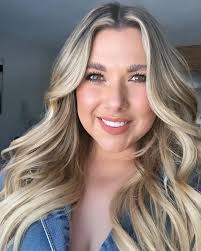Hair Extensions for Fine and Thin Hair: What You Need to Know
If you have fine hair, you've probably thought about extensions at some point. Maybe you dream about having thicker, fuller hair. But then the worry kicks in: what if extensions damage what you already have? What if they make things worse?
I get it. Your hair is already delicate. The last thing you want is to do something that's going to cause more problems.
Here's what I've learned after years of working with clients who have fine hair: extensions can absolutely work for you. But you have to approach them differently. You need the right method, the right application, and honestly, a stylist who really understands how to work with fragile hair.
Let me walk you through what actually works.
Why Fine Hair Is Different
Fine hair needs special care because of how it's built. When we say "fine," we're talking about the diameter of each individual strand, not how much hair you have total. Fine strands are thinner, which makes them more fragile.
Here's what that means for extensions:
Each strand is less strong than coarse hair. It can't handle as much weight or stress.
Too much weight from a heavy extension can put tension on the follicle. That can lead to damage or even hair loss if it's not done carefully.
With less density overall, there's less surrounding hair to help distribute the weight. That means placement has to be really precise.
This is where damage happens. When someone doesn't understand fine hair and just applies extensions the same way they would on thick hair, that's when you get problems.
The goal is to use methods that respect how delicate the hair is and distribute weight so evenly that you barely feel it.
The Methods That Actually Work
Not all extension methods are good for fine hair. You need options that are lightweight, that can be customized to your specific hair, and that minimize how much they're pulling on your natural hair.
Based on what I've seen work consistently over the years, here are the best options.
Hand-Tied Wefts
This is one of my favorite methods for fine hair. Instead of attaching thick wefts to small sections, we create a track using tiny beads and thread. Then the lightweight weft gets sewn onto that track.
Why it works: The weight spreads across the entire track instead of pulling on individual strands. There are very few contact points, so it's comfortable, secure, and incredibly gentle on the hair.
I had a client named Sarah who was nervous about extensions because her hair was so fine. We did hand-tied wefts and she was shocked at how light they felt. She said, "I forget they're even there." That's how it should feel.
K-Tips (Keratin Bonds)
Don't let the word "bond" scare you. When these are done right, they're one of the most customizable and discreet options you can get. The stylist uses a small heating tool to attach a tiny keratin bond (with real human hair attached) to a small section of your natural hair.
Why it works: The bonds are about the size of a grain of rice. They can be cut even smaller for really fine hair. You can place them exactly where you need volume without any heaviness. Each bond moves naturally in every direction, so there's no tension.
Genius Wefts
This is like an upgraded version of hand-tied wefts. They're ultra-thin and lightweight but you can cut them anywhere along the seam without them shedding. That means you can customize the fit perfectly.
Why it works: For people who need a really tailored application, these give you a seamless look without any bulk. They're fantastic for thin hair.
Application Is Everything
Even the best extensions can cause damage if they're not applied correctly. This is why finding the right stylist matters so much.
Here's what a good stylist will do to protect your fine hair:
Perfect sectioning. Clean, precise sections mean no stray hairs get pulled into the bond or bead. That's a common cause of tension and pain.
Strategic placement. The extensions need to be placed far enough from the scalp to allow natural movement. They should be away from your hairline so they stay hidden.
Balanced weight. A trained stylist knows exactly how much natural hair is needed to support each weft or bond. The weight has to be distributed perfectly.
The right maintenance schedule. You'll need move-ups every 6 to 8 weeks typically. Staying on schedule prevents matting and makes sure everything grows out safely with your natural hair.
I've seen too many clients come to me after having extensions done badly somewhere else. The most common problem? Poor placement and too much weight on too little hair. When we redo them properly, the relief on their face says everything.
Making Everything Blend Naturally
The goal is for nobody to know you're wearing extensions. They should just see gorgeous, healthy-looking hair. That's it.
Getting there requires real skill:
Custom color matching. Using two or three different shades creates natural dimension. It helps the extensions melt into your hair, especially if your natural color isn't one uniform shade.
Thoughtful placement. For fine hair, we often place extensions to create fullness on the sides and throughout, not just length at the ends. That gives you a much fuller, more believable result.
The blending cut. This is critical. After the extensions are in, we cut everything together using techniques like point cutting and texturizing. This erases any visible lines and makes the extensions and your natural hair move as one piece.
My client Jennifer had been to two other stylists before coming to me. Both times, you could see exactly where her extensions started. The blending was terrible. When we did them right with proper cutting and placement, she actually teared up. She said, "This is what I've been trying to get for two years."
Quality Matters More with Fine Hair
I know it's tempting to go with a cheaper option. But with fine hair especially, cutting corners will cost you more in the long run. Damage is expensive to fix, both financially and emotionally.
Investing in quality extensions (real Remy human hair) and a properly trained stylist is an investment in your hair's health and future. Quality extensions look better, feel better, last longer, and are so much kinder to your natural hair.
A stylist with real training in fine hair can give you the transformation you want with complete confidence and peace of mind.
Your Questions About Extensions for Fine Hair
Will extensions make my hair loss worse?
Not when they're applied correctly. Lightweight methods like hand-tied wefts and K-tips are designed specifically to prevent tension. A good stylist will do a thorough consultation to make sure your hair is healthy enough and will use techniques that protect your follicles.
How long do they last?
Hand-tied wefts and Genius wefts need move-ups every 6 to 8 weeks. K-tips can last 3 to 5 months before they need to be removed and replaced.
Can I still wear my hair up?
Yes. A skilled stylist places the bonds or wefts strategically, keeping them away from the hairline. You can wear ponytails and updos without anyone seeing them.
What does maintenance involve?
Use sulfate-free products. Brush gently from the ends up. Sleep in a loose braid to prevent tangling. And keep your scheduled move-up appointments. Your stylist should give you clear instructions on all of this.
You Can Have the Hair You Want
The fear of damage is real, I understand that. But when extensions are done right, by someone who understands fine hair, they can completely change how you feel about yourself.
I've watched clients with fine hair walk in feeling self-conscious about how thin their hair is. And I've watched them leave with confidence they haven't felt in years. That transformation isn't just about the hair. It's about how they see themselves.
You deserve that too.
If you're ready to explore extensions, find a stylist who specializes in fine hair. Have a real consultation. Ask questions about their training and their experience with delicate hair. Look at their work on clients with hair like yours.
The right person will be honest with you about what's possible. They'll prioritize your hair's health above making a sale. And they'll give you realistic expectations about maintenance and care.
That's how you get beautiful, damage-free volume that actually lasts.

Tiffany Loe
Owner & Master Stylist
Hair extension expert and salon owner with a passion for helping stylists succeed. Tiffany has been transforming hair and building confidence for over 15 years.




